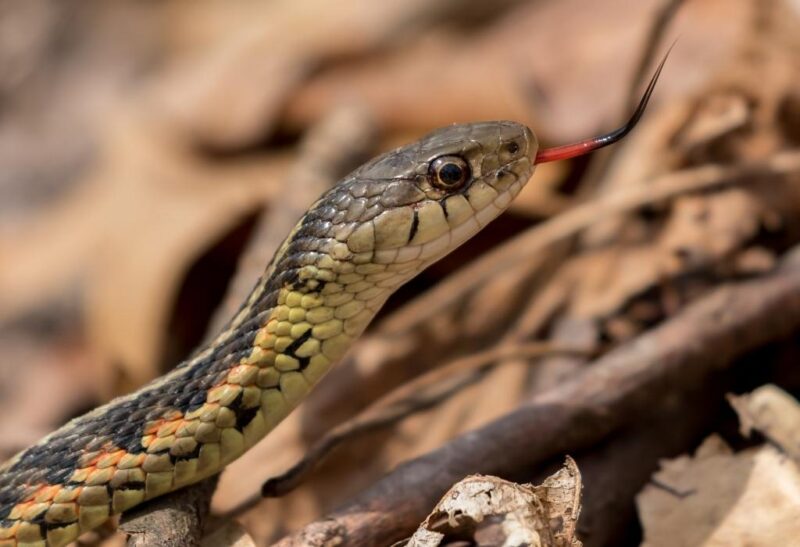Lake Michigan and Lake Superior in Michigan are home to numerous animals. These are the places where you can find water snakes that wander and hunt for food.
There’s an abundant food supply in those lakes. Water snakes also prey on animals that approach the lake for a drink.
What are the different snakes in Michigan? The common snakes in Michigan are Kirtland’s snake, Queen snake, Northern Ribbon snake, Eastern Massasauga Rattlesnake, Copperbelly water snake, and Northern water snake.
These snakes have dark coloring, but they have distinct patterns. Hence, you can distinguish them easily when you see them. So, let this article guide you.
Table of Contents
Are There Venomous Water Snakes in Michigan?
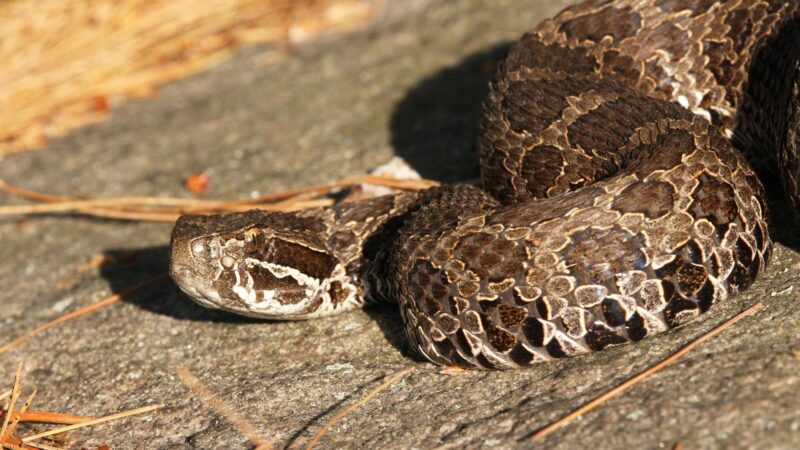
Eastern Massasauga Rattlesnake is the only venomous water snake in Michigan. The majority of this snake occupies wetland habitats, and the rest is in the nearby upland.
Being said that Eastern Massasauga is venomous, it’s a timid species. It doesn’t like getting attention as it prefers to hide under vegetation.
If ever its hiding place is disturbed, its first reaction is to move to a more secluded area. Due to its secretive behavior, people in Michigan rarely see this snake. This snake remains at the same site.
Even after hibernation, they will go back to the same place that suits them. So, some Eastern Massasauga rattlesnakes die when they couldn’t find the right place after winter.
6 Water Snakes in Michigan
Kirtland’s Snake
This snake is an endangered species in Michigan and is labeled as threatened in Indiana. Its population declined because of its inclination to dwell in big cities where development and pollution exist. Nonetheless, it likes to live in wet fields and marsh edges.
- Scientific Name: Clonophis kirtlandii
- Appearance: The upper body of Kirtland’s snake is covered by gray-keeled scales. There are two rows of small blotches, and a bigger one is in the middle. These blotches are all dark. It has a reddish belly with black spots. This snake has a dark head, but the chin and throat are white.
- Color: Green, grey, brown, and red
- Lifespan: Up to 8 years
- Length: Around 2 feet
- Diet: Earthworms, leeches, and slugs
- Place of Origin: South of Michigan, North-central Kentucky, Illinois, Indiana, and Ohio
- Venomous: No
Queen Snake
A queen snake likes a partly shaded or open place. Hence, it can be found in shallow waters or on the edges. It’s fond of staying on a tree or basking on logs and rocks. Some queen snakes hibernate in a burrow of crayfish and mammals.
- Scientific Name: Regina septemvittata
- Appearance: It has an olive-colored or brownish body with a yellow band that goes horizontally. You may think of it as a garter snake, but the difference is its divided anal plate.
- Color: Yellow, olive, and brown
- Lifespan: Up to 9 years
- Length: Up to 3 feet
- Diet: Amphibians, aquatic crustaceans, and fish
- Place of Origin: Florida
- Venomous: No
Northern Ribbon Snake
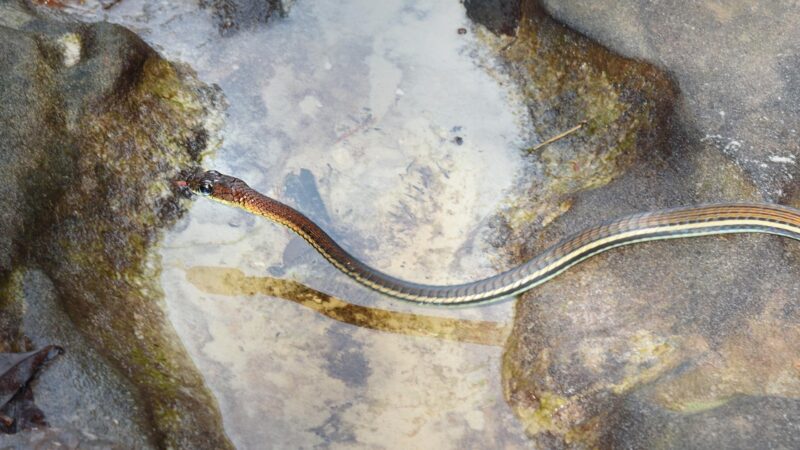
Due to its slim body, this snake is active and fast-moving. It’s a solitary creature, but it’s active during the day along water edges. You may also see them in moist meadows. A Northern Ribbon snake likes to bask on rocks, logs, and bushes.
- Scientific Name: Thamnophis sauritus
- Appearance: It has a slim profile with stripes and a long tail. These stripes are colored green, yellow, and white. Its head is wider than its neck. It may look similar to garter snakes, but it has relatively bigger eyes.
- Color: Green, yellow, white, black, and dark brown
- Lifespan: Up to 10 years
- Length: Up to 2.8 feet
- Diet: Amphibians, fish, and worms
- Place of Origin: Northeast of the United States
- Venomous: No
Eastern Massasauga Rattlesnake
This is a medium-sized snake with a thick body that is coiled most of the time. It has a body filled with dark, irregular blotches and stripes, which are lighter in color compared to the background.
As a member of the pitviper group, it’s venomous, so it has elliptical eyes. Since it’s a rattlesnake, there are several segments on its tail that vibrate and create a rattling sound.
- Scientific Name: Sistrurus catenatus Massasauga
- Appearance: The background color can either be gray or grayish brown. Dark blotches are above it, while there are white spots too. The cat-like pupils are on its triangular head, and there’s a pit in the middle of its nostrils and eyes. Its single anal scale is noticeable.
- Color: Brown, gray-brown, or gray
- Lifespan: Up to 20 years
- Length: Up to 3.2 feet
- Diet: Mammals, amphibians, vertebrae
- Place of Origin: Nearctic region
- Venomous: Yes
Copperbelly Water Snake
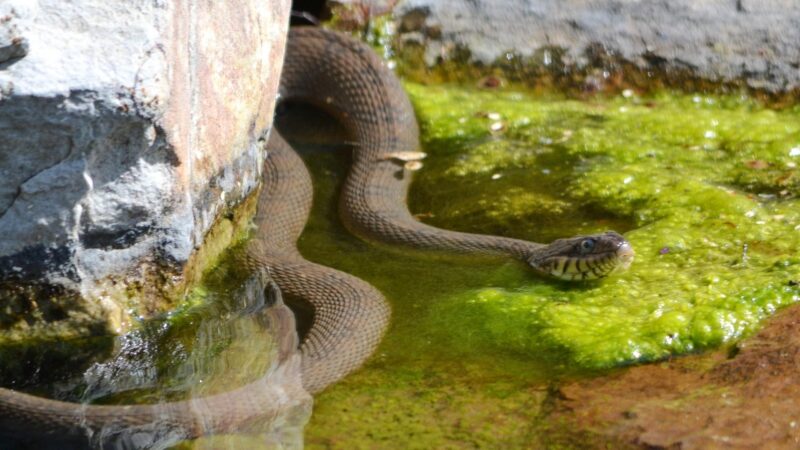
The favorite place of this snake is warm, quiet waters. This is an endangered snake in Michigan, Indiana, and Ohio. The decline in the population of Copperbelly water snakes happened because of pollution, drainage, filling, and loss of their habitat.
- Scientific Name: Nerodia eythrogaster neglecta
- Appearance: It has a dark appearance that is either bluish or brown. Moreover, it’s relevant for camouflage as this snake tends to be cryptic and secretive.
- Color: Bluish, black, brown, and orange-red
- Lifespan: 8 to 15 years
- Length: Up to more than 5 feet
- Diet: Frogs, tadpoles, and fish
- Place of Origin: Michigan, Indiana, and Ohio
- Venomous: No
Northern Water Snake
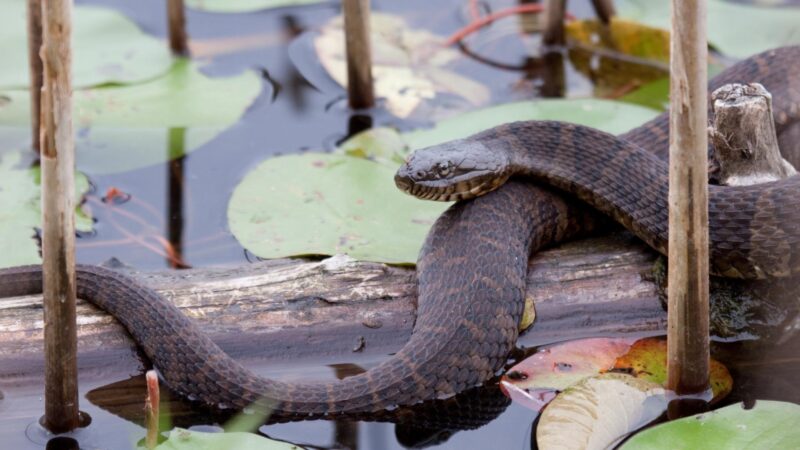
This species lives in various aquatic habitats such as lakes, ponds, marshes, bogs, streams, and rivers. It prefers an open area where there’s enough space and still water for basking.
Also, it can be found beneath logs, flat rocks, boards, and other sorts of cover. This snake is abundant within their range. However, people kill it, as this snake is mistaken as a venomous rattlesnake.
- Scientific Name: Nerodia sipedon
- Appearance: You’ll see Northern water snakes either in tan, brown, or gray hue. There’s also a band on its body with a pattern of alternating blotches.
- Color: Brown, tan, gray, black, yellow, and orange
- Lifespan: Up to 9 years
- Length: Up to 4.5 feet
- Diet: Amphibians, birds, mammals, carrion, insects, fish, aquatic crustaceans, and non-insect arthropods
- Place of Origin: Northeastern side of the United States
- Venomous: No
Frequently Asked Questions
How Big Do Michigan Water Snakes Get?
The Northern water snake is not the only widely distributed species in the list of water snakes in Michigan. It’s also the species that can grow the longest at the length of 6 feet.
Are There Snakes in Lakes in Michigan?
There are snakes in lakes in Michigan as it’s home to a variety of animals. There are snakes in and near the water that are called semi-aquatic snakes.
A couple who was kayaking in Lake Michigan thought that they saw a large rattlesnake. Later on, it was identified as a Massasauga rattlesnake. The couple didn’t harm it and just let it return to the water.
Do Water Snakes Bite?
Water snakes will surely bite when you harass or pick them up. Before they bite, there are warnings like giving a hissing sound or flattening their bodies so they’ll look big.
Be wise and keep distant from them. Some of them don’t want attention. When you see a snake, just look at it.
Water snakes are generally non-venomous. But they have a row of teeth that can sink into your skin and leave a wound.
Based on their length, they’re large snakes, so you can expect that their bite is painful. Anyway, water snakes are not after humans since they feed on animals that live or near the water.
Can Snakes Swim Up Toilets?
There are two ways that snakes can swim up toilets. The first one is when they follow a rat to prey on. This small critter goes to the sewer until it reaches the toilet.
A snake can get through the said passage. It happened in Bangkok, Thailand, and a man’s private part was severed after a python was yanking on it.
He was clueless when he sat down on the toilet where the snake was. It’s easy for a snake to come out of the toilet as there’s only a little water in the bottom of the bowl. Water Snakes Are Much Maligned
Secondly, a snake can also get into a house through the door or window. Then, it finds a cool area so it can end up in your bathroom or through the bathroom pipes.
Summary
The lakes in Michigan are ideal habitats for water snakes. Luckily, only the Eastern Massasauga Rattlesnake is venomous. But still, you don’t have to get in contact with or bother any water snakes.
They won’t bite unless you provoke them. After all, they don’t cause inconvenience or direct harm to humans since they only prey on animals in and around the body of water.
List of Sources
Kleopfer, J. D. (2019). Snakes on the Water. Virginia Department of Wildlife Resources.
Gillilland, M. (2013). Nerodia sipedon. Animal Diversity Web.
Gibbons, W. (2002). Water Snakes Are Much Maligned. University of Georgia.
Eastern Massasauga Rattlesnake. Michigan State University.
Kauzlarich, K. (2000). Clonophis kirtlandii. Animal Diversity Web.
